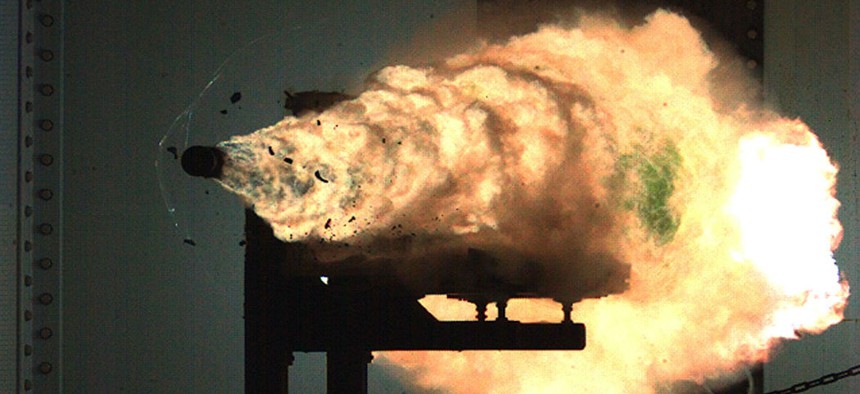
General Atomics claims railgun advance
Electromagnetic modules are said to double energy density for power-hungry kinetic weapon.
Railgun technology that uses electricity and high velocities rather than explosives to destroy targets has a checkered past. One reason is the huge amount of energy required to launch projectiles at high Mach numbers.
General Atomics reports progress toward solving the energy problem with an electromagnetic energy module that delivers what the San Diego-based company claimed is twice the energy density of existing systems used to power railguns.
Energy density is a measure of the amount of energy that can be stored in the mass of a system. Higher energy density translates into greater stored energy. General Atomics announced last week that its High Energy Pulsed Power Container doubles energy density and could therefore be used to reduce the number of pulsed power containers required to launch projectiles from railguns.
General Atomics' Electromagnetic Systems unit has over the past decade provided pulsed power systems for the Navy's railgun program. "What we have packed into a 10-foot standard shipping container is equivalent to what is currently available in a 20-foot shipping container, doubling the energy density," explained Nick Bucci, vice president of the General Atomics unit.
While the company is touting the advance as a more compact energy source aboard warships, it also is pitching it as a potential energy source for mobile land forces.
The company committed more than $50 million in internal funding last year for railgun development in hopes of attracting renewed Army and Navy interest in the technology. The pulsed power container development is in support of its 10 megajoule Multi-mission Medium Range Railgun Weapons System. The platform integrates pulsed power, launcher, missile and fire control.
Based on the company's high-energy density capacitors used to store energy in an electrical field, the pulsed power modules deliver about 415 kilojoules per module.
Bucci said the company is currently performing risk reduction testing in order to ready the technology for possible deployment. It is also testing hybrid missiles that destroy targets with kinetic energy rather than explosives. Testing is scheduled to continue through the rest of this year.
Railguns launch projectiles using electromagnetic forces rather than chemical propellants at roughly twice the muzzle velocity of conventional guns.
The proposed multi-mission railgun is intended to replace the Navy's current 5-inch guns, and the company said its designed could be modified for smaller vessels such as the Navy's Littoral Combat Ship. The new design is based on General Atomics' 3-megajoule Blitzer railgun. That electromagnetic weapon was demonstrated last year and is being considered as a truck-mounted weapon.
The proposed Navy railgun incorporating new electromagnetic energy modules would be used to intercept missiles and enemy aircraft as well as kinetic strikes on sea and land targets. Among the railgun's selling points is cost: hybrid missiles fired by railguns would be much cheaper than today's multimillion-dollar conventional missiles, company officials have noted.